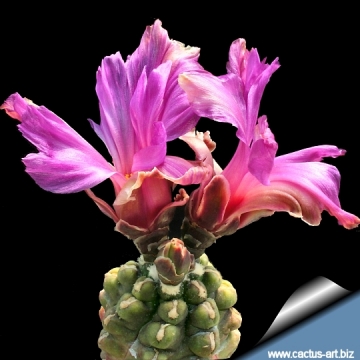Donate now to support the LLIFLE projects.
Your support is critical to our success.
Your support is critical to our success.

Thelocactus bicolor cv. inermis Photo by: Valentino Vallicelli
Synonyms:
See all synonyms of Thelocactus bicolor
back
Accepted name in llifle Database:Thelocactus bicolor (Galeotti ex Pfeiff.) Britton & Rose
Bull. Torrey Bot. Club 49: 251. 1922
Synonymy: 20
- Thelocactus bicolor (Galeotti ex Pfeiff.) Britton & Rose
- Cactus bicolor Teran & Berland.
- Echinocactus bicolor Pfeiff. in Pfeiff. ex Pfeiff.
- Echinocactus rhodophthalmus Hook.
- Echinocactus rhodophthalmus var. ellipticus Hook.
- Ferocactus bicolor (Galeotti ex Pfeiff.) N.P.Taylor
- Hamatocactus bicolor I.M.Johnst.
- Thelomastus bicolor (Galeotti ex Pfeiff.) Frič in Kreuz.
- Thelocactus bicolor var. commodus R.Haas
- Thelocactus bicolor subs. commodus (R.Haas) Doweld
- Thelocactus bicolor var. schottii (Engelm.) Krainz in Krainz
- Echinocactus bicolor var. schottii Engelm.
- Echinocactus schottii Small
- Thelocactus schottii (Engelm.) Kladiwa & Fittkau
- Thelocactus bicolor subs. swobodae Halda & Horáček
- Thelocactus bicolor var. texensis Backeb.
- Thelocactus bicolor var. tricolor (K.Schum.) F.M.Knuth in Backeb. & F.M.Knuth
- Echinocactus bicolor var. tricolor K.Schum.
- Echinocactus bicolor f. tricolor (K.Schum.) Schelle
- Thelocactus bicolor subs. zwakii Chvastek & Halda
Thelocactus bicolor subs. bolaensis (C.Runge) Doweld
Sukkulenty 1(2): 30, 1999 ( bolansis )
Synonymy: 13
- Thelocactus bicolor subs. bolaensis (C.Runge) Doweld
- Echinocactus bicolor var. bolaensis (C.Runge) K.Schum.
- Echinocactus bicolor f. bolaensis (C.Runge) Schelle
- Echinocactus bolaensis C.Runge
- Ferocactus bicolor var. bolaensis (C.Runge) N.P.Taylor
- Thelocactus bicolor var. bolaensis (C.Runge) A.Berger
- Thelocactus bicolor var. bolansis (K.Schum.) F.M.Knuth
- Thelocactus bolansis hort.
- Thelomastus bicolor bolansis (C.Runge) Frič in Kreuz.
- Thelocactus bicolor var. wagnerianus (A.Berger) Krainz in Krainz
- Echinocactus wagnerianus var. A.Berger A.Berger
- Thelocactus wagnerianus A.Berger
- Thelomastus bicolor wagnerianus (A.Berger) Frič in Kreuz.
Thelocactus bicolor subs. flavidispinus (Backeb.) N.P.Taylor
Cactaceae Consensus Init. 5: 14. 1998
Synonymy: 4
- Thelocactus bicolor subs. flavidispinus (Backeb.) N.P.Taylor
- Ferocactus bicolor var. flavidispinus (Backeb.) N.P.Taylor
- Thelocactus bicolor var. flavidispinus Backeb.
- Thelocactus flavidispinus Backeb.
Thelocactus bicolor subs. heterochromus (F.A.C.Weber) Mosco & Zanov.
Bradleya 18: 62 (2000)
Synonymy: 11
- Thelocactus bicolor subs. heterochromus (F.A.C.Weber) Mosco & Zanov.
- Echinocactus heterochromus F.A.C.Weber
- Ferocactus heterochromus N.P.Taylor
- Thelocactus heterochromus (F.A.C.Weber) Oosten
- Thelomastus heterochromus (F.A.C.Weber) Frič in Kreuz.
- Thelocactus bicolor var. pottsii (Schur ex Salm-Dyck) Backeb.
- Echinocactus bicolor var. pottsii Schur ex Salm-Dyck
- Echinocactus bicolor f. pottsii (Schur ex Salm-Dyck) Voss in Vilm.
- Echinocactus pottsii Schur ex Salm-Dyck
- Thelocactus pottsii (Schur ex Salm-Dyck) Britton & Rose
- Thelocactus heterochromus longispinus
Thelocactus bicolor subs. schwarzii (Backeb.) N.P.Taylor
Cactaceae Consensus Init. 5: 14. 1998
Synonymy: 4
- Thelocactus bicolor subs. schwarzii (Backeb.) N.P.Taylor
- Ferocactus bicolor var. schwarzii (Backeb.) N.P.Taylor
- Thelocactus bicolor var. schwarzii (Backeb.) E.F.Anderson
- Thelocactus schwarzii Backeb.
back

Thelocactus bicolor cv. inermis Photo by: Valentino Vallicelli

Thelocactus bicolor cv. inermis Photo by: Diego Armentano

Thelocactus bicolor cv. inermis Photo by: Valentino Vallicelli

Thelocactus bicolor cv. inermis Photo by: Cactus Art

- Spineless cultivar with flamboyant jagged flowers. Photo by: Valentino Vallicelli

Thelocactus bicolor cv. inermis Photo by: Valentino Vallicelli
| Your Actions | |
|---|---|
| Back to Thelocactus index | |
| Back to Cactaceae index | |
 |
Back to Cacti Encyclopedia index |








